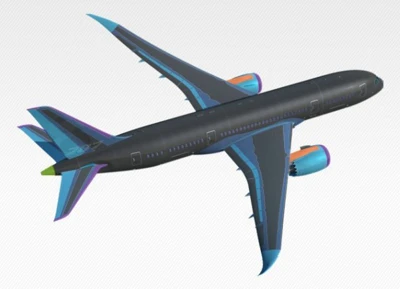Why is Carbon Fiber Preferred for Aircraft Bodies?
 With the Boeing 787 Dreamliner and the Airbus A350 XWB leading the way, commercial airlines are progressively making greater use of carbon fiber composites to build aircraft bodies. Because carbon fiber is stronger than steel, lighter than aluminum, and can be molded into virtually any shape; it’s no wonder that aerospace engineers design their dream planes with carbon fiber composite structural materials. Add reduced fuel costs, improved aerodynamics, and fewer parts requirements, it’s easy to see that carbon fiber is primed to become the preferred aircraft structural material of the future.
With the Boeing 787 Dreamliner and the Airbus A350 XWB leading the way, commercial airlines are progressively making greater use of carbon fiber composites to build aircraft bodies. Because carbon fiber is stronger than steel, lighter than aluminum, and can be molded into virtually any shape; it’s no wonder that aerospace engineers design their dream planes with carbon fiber composite structural materials. Add reduced fuel costs, improved aerodynamics, and fewer parts requirements, it’s easy to see that carbon fiber is primed to become the preferred aircraft structural material of the future.
Carbon Fiber Increases Fuel Efficiency
It’s no secret that in the airline industry, the lighter the aircraft, the less expensive it is to operate. Lower weight improves fuel efficiency, which significantly decreases the overall cost to operate planes. Since carbon fiber composites are incredibly strong and stiff for their weight, it makes sense that aircraft manufacturers are leaning more and more in that direction. Using carbon fiber composites to build an airplane reduces its weight by up to 20%, versus the weight of a traditional aluminum plane. For each kilogram of weight reduction, experts estimate a savings of about $1 million in costs over the life of the plane. That adds up to enormous savings!
Carbon Fiber Improves Aerodynamic Performance
In addition to decreasing weight, another important factor for aircraft fuel efficiency is aerodynamics. The sleeker the design, the more fuel-efficient the plane becomes. Because carbon fiber composite fabrication processes can produce very smooth yet complex geometries, aircraft designers can more easily optimize the aerodynamics of a carbon fiber aircraft. Additionally, the stiffness of carbon fiber facilitates the use of swept wing designs in commercial aircraft, which cuts fuel consumption by up to 5%, by reducing aerodynamic drag.
Carbon Fiber Reduces the Number of Parts
Another area where using carbon fiber in manufacturing aircraft helps reduce costs is in the number of parts needed to build the plane. For example, the Airbus A380 is typically built with approximately six million parts. However, since carbon fiber composite parts are molded, each mold can be designed so that several different parts are combined into one mold, thereby significantly reducing the number of parts needed to build the plane. With fewer components needed to build the plane, less manufacturing time is also required. Furthermore, because carbon fiber parts weigh less, fewer people are needed to maneuver and assemble them. All of these factors add up to significant cost savings in the manufacturing of the aircraft.
Future Aircraft Designs Using Carbon Fiber
Using carbon fiber to build aircraft, instead of traditional metals, offers aircraft designers more flexibility when it comes to manipulating aerodynamic efficiency and saving fuel. This flexibility allows the opportunity to change up traditional plane designs as well. Future commercial aircraft could include designs where the fuselage and wings blend together, similar to some military aircraft today. This type of design greatly improves a plane’s lift-to-drag ratio, making the plane more aerodynamically efficient while still reducing weight. A recent Airbus concept plane introduced a plane with a fatter, curved fuselage, designed to improve airflow and provide more cabin space. Longer, thinner wings would reduce drag and improve fuel efficiency. A U-shaped tail acts as a shield to reduce engine noise. It is carbon fiber that allows all these concepts to even be conceived.
While carbon fiber has been used in aircraft construction since the 1970s, as manufacturing techniques improve, it is becoming more commonplace to seek new ways to use this incredible resource in the design and manufacturing of commercial airplanes. Because of their lightweight, incredible strength, and smooth finish, carbon fiber composites are an ideal material from which to build many parts of an aircraft. The use of carbon fiber for aircraft bodies allows them to be more fuel-efficient, more aerodynamic, and to be built with fewer and lighter parts. All of these factors add up to reduced costs in both manufacturing and operations. It’s no wonder today’s concept planes make greater use of carbon fiber composites—clearly, carbon fiber will become the major material used to build aircraft bodies of the future.
For more information on uses of carbon fiber, visit our Applications for Carbon Fiber page.